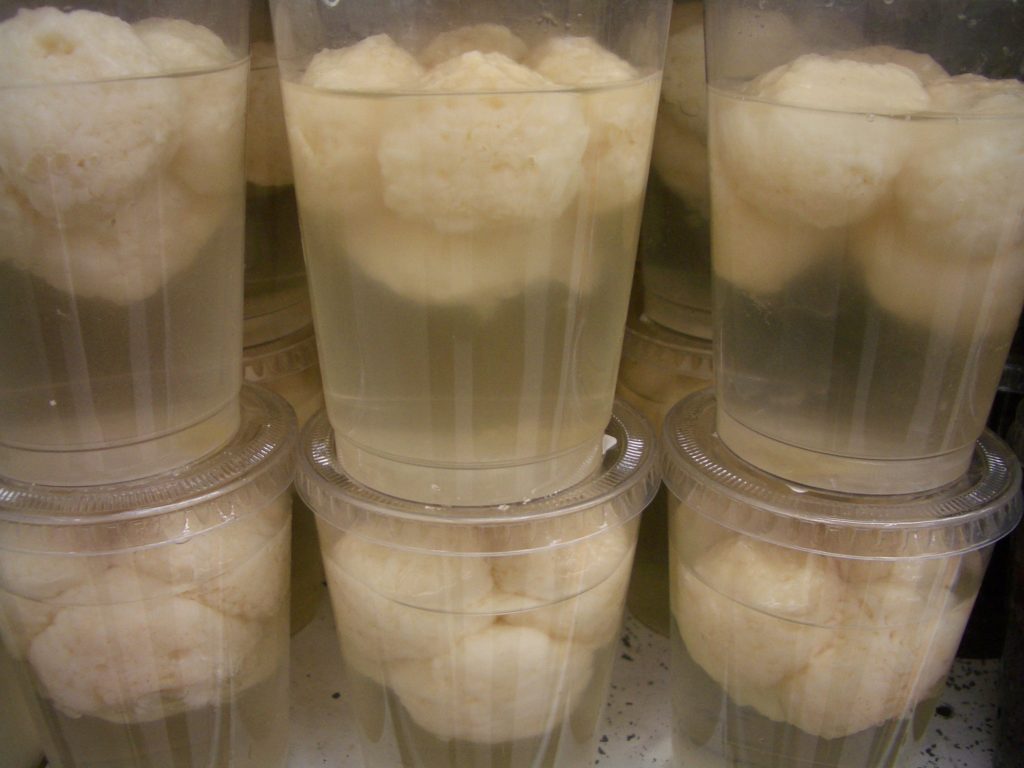They are also tasty, thanks to the process of fermentation in which microbes break down food, creating chemical changes that enhance flavour.
You’ll find such foods everywhere in Southeast Asia, where fermentation serves to prevent food from spoiling in the hot and humid climate.
Com ruou
Southeast Asia produces almost 30 percent of the world’s rice, so naturally, rice dishes are popular in the region.
One of the most well-known in Vietnam is com ruou, prepared using glutinous rice that has been steamed, inoculated with men ruou (yeast starter) and allowed to ferment.
 These sweet, slightly astringent sticky rice balls are a must-have on Tet Doan Ngo (Pest-Killing Festival) as it is believed that com ruou can ward off digestive “pests”.
These sweet, slightly astringent sticky rice balls are a must-have on Tet Doan Ngo (Pest-Killing Festival) as it is believed that com ruou can ward off digestive “pests”.
Similar dishes in the rest of the region include khao mak in Thailand, tapai pulut in Malaysia and tape ketan in Indonesia.
Laphet
Myanmar is among the few countries in the world where tea leaves are also eaten.
One popular dish is laphet thoke, a salad made from tea leaves that are steamed, wrapped in burlap sacks and left buried underground to ferment for roughly six months.
 The fermented tea leaves have a sour pickled herb flavour with a mild aftertaste of tea, so faint that most people unfamiliar with the dish wouldn’t even know they’re eating tea leaves.
The fermented tea leaves have a sour pickled herb flavour with a mild aftertaste of tea, so faint that most people unfamiliar with the dish wouldn’t even know they’re eating tea leaves.
The salad includes peanuts, broad beans, garlic, dried shrimp and chillies, but there are many variations such as dan yhin thee laphet thoke, which includes djenkol beans, and pyaung hpu bae ou laphet thoke, made with corn and duck eggs.
Besides Myanmar, tea leaf salad can also be found in northern Thailand where the ethnic Shan people live. The salad is known as niang ko in Shan and yam miang in Thai.
Tempeh
Tempeh is a traditional soya product from Indonesia, fermented using a starter containing Rhizopus spores and rice flour to bind the soya beans into a dense, compact cake.
Although tempeh is made mainly from soya beans, it may include other beans and grains or be made with soya pulp (tempe gembus), peanut press dregs (tempe menjes) or coconut dregs (tempe bongkrek).
 High in protein, vitamins and minerals but low in sodium and carbs, tempeh is a popular meat alternative for vegetarians and vegans.
High in protein, vitamins and minerals but low in sodium and carbs, tempeh is a popular meat alternative for vegetarians and vegans.
This is because tempeh, with its mildly nutty, earthy taste, goes with nearly any dish. It can even be made to taste like meat.
Aside from stir-frying it with sambal and kecap manis (sweet soya sauce), Indonesians will happily mix tempeh with egg, meat, liver or gizzard – basically any part of an animal.
Som pak gaat
Pickled mustard greens can be found across Southeast Asia, possibly due to the influence of China, where it is an important vegetable.
In Laos, pickled mustard greens are called som pak gaat and are often served alongside dishes like grilled fish, larb (minced meat salad) and green papaya salad.
To make this “Laotian kimchi”, all you need are mustard greens and rice brine. After being left to ferment for two to three weeks, the mixture develops sour and pungent flavours.
Pickled mustard greens are known as dua cai chua in Vietnam, jrouk spey in Cambodia, sayur asin in Indonesia and burong mustasa in the Philippines.
Tempoyak
This one’s strictly for durian lovers – tempoyak or fermented durian.
Found in Malaysia, Brunei and Indonesia, tempoyak is often made into a spicy condiment like sambal tempoyak or mixed into curries like gulai tempoyak.
The fermentation can either be a natural process where mashed durian flesh is salted and stored in an airtight container or using a lactic acid bacteria culture.
 The practice of fermenting durian came about as a way to use overripe or lesser quality durians, and as a way to enjoy the king of fruits until the next durian season.
The practice of fermenting durian came about as a way to use overripe or lesser quality durians, and as a way to enjoy the king of fruits until the next durian season.
Interestingly, the fermentation process removes most of the acrid smell durian is known for, and tempoyak, with a texture akin to mayonnaise, imparts a lovely creaminess and salty-sour flavour to dips and curries.
According to airasia.com














